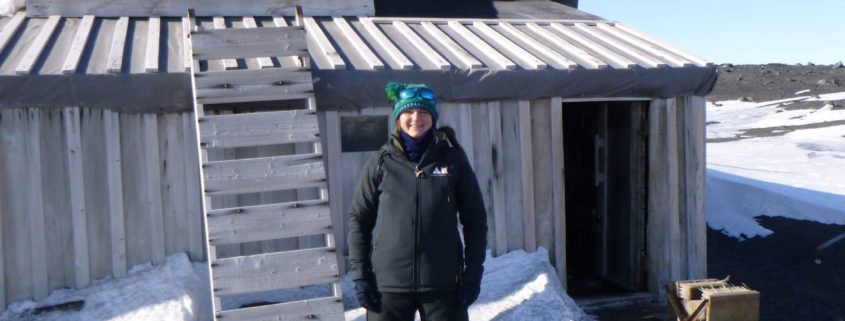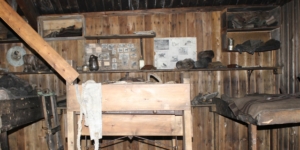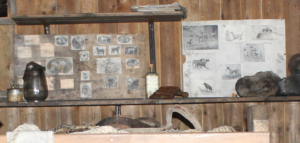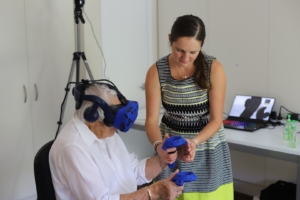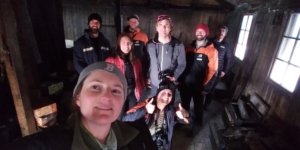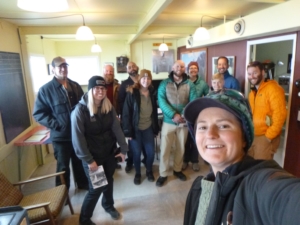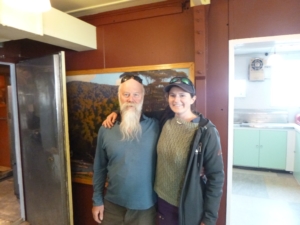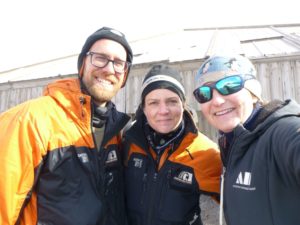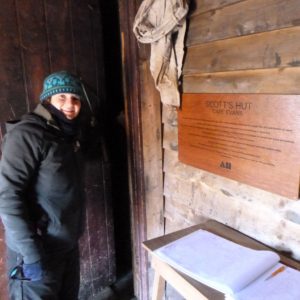Life at the South Pole today gives perspective on Antarctica’s heroic-era explorers
Life at the South Pole today gives perspective on Antarctica’s heroic-era explorers
By Sarah Bouckoms (AHT alumni)
I grew up reading Disney stories, but as I got older I came to believe that fairy tales weren’t real, so I got myself some new heroes. They too only existed in books. These iron men in wooden ships sailed down to the Antarctic and walked across icy deserts with no map in pursuit of a particular place on the polar plateau, the South Pole, all in the name of science and exploration.
The books I read told stories of frozen sledging harnesses, bunk beds in cramped quarters, and meals of seal and pemmican with the exception of jubilant mid-winter dinner celebrations. Many years later, walking into the explorer bases on Ross Island made me realize that these paperback heroes were actually people. They put pictures of dogs on their walls, and took their hot water bottles and slippers on major expeditions. I too had pictures of dogs on the wall and red slippers under my bed. I cherished seeing these artefacts because it made them seem more human. If it makes them seem soft, however, that is just an illusion.
My latest experience in Antarctica, working for the United States Antarctic Programme, has been different to the many times I’ve been before. It has completely changed my perspective on Antarctica’s heroic-era explorers. As the physical challenges, the discomfort they endured, and the mental crevasses they pulled themselves out of became more real to me (through my own experiences living and working in Antarctica) their feats became even more unreal. I am in awe.
Before I deployed to Antarctica in October 2021, I had been into Hillary’s Hut almost every day for the past year – virtually. While working as Antarctic Heritage Trust’s Public Engagement Officer I toured the Trust’s virtual reality experience of Hillary’s Hut around New Zealand schools and community groups.
I had only been inside it for real once before, in 2008, when I was in Antarctica conducting research for my Post Graduate Certificate in Antarctic Studies at the University of Canterbury. While spending two weeks camping out on the Ross ice shelf in a Scott Polar tent, I read Aspley Cherry-Garrard’s story, The Worst Journey in the World, between science experiments. It was then that my captivation with the heroic-era of Antarctic exploration began. It remained an interest as my life took a series of tacks and gybes, but eventually, I found a way to share the inspiration I had found in the early Antarctic explorers with the next generation of Hillarys and Shackletons.
In 2019 I was the Programme Manager for the Trust’s inaugural Young Inspiring Explorers™ Summit, before taking the Virtual Reality Tour of Hillary’s Hut on the road in late 2020. While doing the VR, the children’s faces lit up as they saw archival footage of husky dogs gliding across the sea ice dragging out rations for depots, and I heard ooooh’s and aaahhh’s as they saw Hillary’s jacket in his room. They couldn’t hold back calls of “I’m hungry” after watching meals being served from the small galley stove or, best of all, the shivers they felt as they held Fuch’s anemometer and saw the wind moving it while caught by a cold katabatic breeze.
The virtual reality experience not only makes the hut accessible for people, but the stories it shares also demonstrate the mindset needed to be an explorer – courage, creativity, resiliency, ingenuity and resourcefulness. I was certainly inspired.
I told everyone who took part in the VR that they were in for a real-life experience, and while I fully stood behind those words, I wanted to have my own Antarctic experience. So, after decades of rejection letters, I was finally offered a job with the United States Antarctic Programme. During my time at McMurdo Base over the summer 2021-22 season I volunteered as a Tour Guide, taking people through Robert Falcon Scott’s Discovery hut, and Hillary’s Hut. I landed on a Tuesday, was trained by Friday and giving tours on my first day off, Sunday.
I had been in Discovery hut before and distinctly remember the smell of the blubber, the horse fodder, the burlap, the wood. In a dry environment where very little smells, the scents of the hut made such an impression. Every time I looked back on a photo of the hut, the smells wafted in on the Antarctic winds. I wanted to help capture that moment for other people, so it came easily for me to show co-workers around, telling stories of desperate attempts by Tom Crean to return with a nearly dead Lieutenant Evans. I pointed out familiar food brands, tins resourcefully turned into candle holders, skis and tent poles. I told people to notice the details because they are the gold that makes this place to special and I made sure they took pictures of themselves in the hut, so they could show family and proudly say I stood where Scott stood. Finally, before they left, I made sure they signed the guest book, securing their own names in history.
While Discovery hut had a familiarity to it, going to Hillary’s Hut felt like I was coming home. After my flight to Antarctica landed and we drove closer to New Zealand’s Scott Base, I saw Hillary’s Hut from a distance, painted in bright Pram Point orange and Snow Cat yellow. My face pressed to the glass, with ice crystals on the window, it quickly fogged up and it was a battle to keep it clear.
On my first trip over to Scott Base I stood outside Hillary’s Hut looking from afar, I couldn’t bring myself to go in. I had to soak it up one bit at a time. I went in two days later, while training to be a hut guide (which was slightly ironic as I knew more about Hillary’s Hut than the person training me). It’s probably good that I didn’t have to be responsible for anyone at that moment. In my mind, I was busy looking after the 5,000 people I had taken through the hut virtually. A maximum of 11 visitors and one guide are allowed in the hut at any time, to keep the impact to a minimum, but I couldn’t leave any one behind so I carried those 5,000 virtual visitors with me in my memories. The school groups, the nursing homes, the families, the scientists, we all got to go.
I was able to view the building and artefacts from new angles, to smell the Pram Point yellow paint, to finally read the small print on a notice above the sink, to feel the warmth of the sunshine streaming through the windows into the galley, and look at the blocks of Cadbury’s chocolate I had resisted virtually so many times before. I was in such an incredible place of privilege.
The VR experience shares this wonderful place with the world, as traveling to Antarctica comes at an incredible cost both financially and environmentally. There I was, the less than one percent who gets to have their own Antarctic experience. I was overwhelmed with emotions of gratitude towards the Trust for preserving these spaces for myself and others to be inspired.
Just as Scott and Hillary used Ross Island as their staging ground to get to the Pole, after a summer season at McMurdo Base, my Antarctic adventures continued on to the South Pole too, but under very different circumstances. I flew in a Basler aircraft, over five hours, with the luxury of being served a warm cookie by the pilots. There was a deafening noise requiring ear plugs, the requirement to wear an oxygen mask because I was travelling in an unpressurized cabin, and the logistics of peeing into a bottle in a moving aircraft to content with, but this was nothing compared to the treks both Scott and Hilary endured.
At the start of the flight I got caught up in my current situation and forgot about those who walked before me. I had my eyes glued out the window into the ping pong ball abyss. The mountains appeared, completely coated in snow and ice and slowly got bigger. They were the most jagged mountain tops I’ve ever encountered, draped with crevasses large enough to see from the air. For a while, the beauty distracted me from thinking of my heroes. Then I remembered people had walked across this landscape, and without a map. I thought, “no way, there is no way anyone could survive that”. But they did. I thought, “thank goodness they didn’t know where they were going or they wouldn’t have gone”. Scott and Shackleton both tried again for the Pole after their first attempt on the Discovery expedition was unsuccessful. How each of them mustered the courage to return, knowing the harrowing conditions, was beyond my capacity to understand. On the flight, I was still wrapping my head around my impending job assignment, I would be working to support science in the most extreme laboratory on this planet.
On my way into the AHT office each day, I would read this quote from Hillary proudly displayed next to the front door, “I am hell bent for the South Pole, God willing and crevasses permitting.” Who knew those doors would be a portal, as I now find myself living at the South Pole over winter 2022.
I have a sauna 100 metres from my warm room with flannel sheets, a greenhouse providing fresh lettuce year-round, and occasional internet providing a link to the outside world (I am rationed not to one very public call a week, but 30 minutes of video chat a week). I know during the long dark winter I will draw upon the inspiration of my heroes and hope that one day I can use my own stories to inspire the next generation of explorers. Just as I saw in the huts, I have slippers under my bed and pictures of dogs on the walls, alongside photos of Hillary, Cherry-Garrad and Tom Crean. While much has changed, a lot hasn’t.
The ability to step into the huts of the early explorers, either in real life or virtually, is only possible today thanks to the dedication of the Trust’s conservation team and the generous donors who support Antarctic Heritage Trust. I’m incredibly grateful for the endless hours put into conserving these incredible places, for my time working with the Trust, and the contagious spirit of exploration that inspires me and the 5,000 people I’ve taken into the huts virtually.

